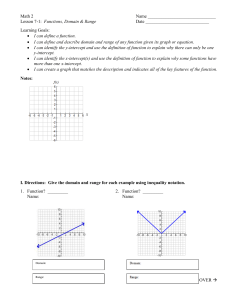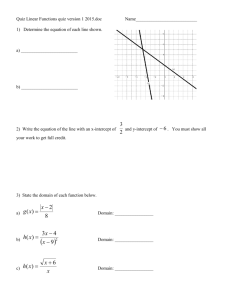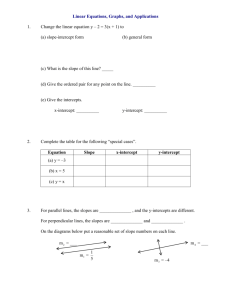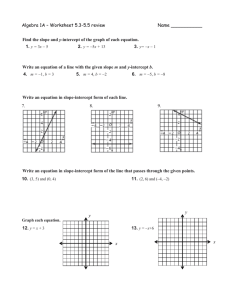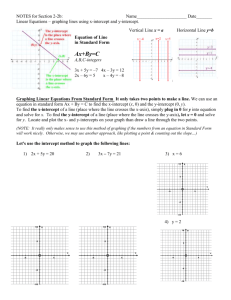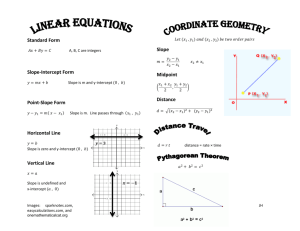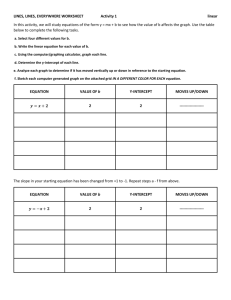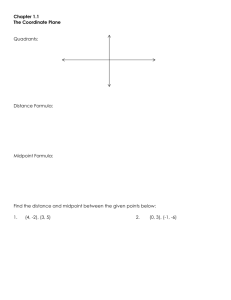Chapter 2: Review
advertisement
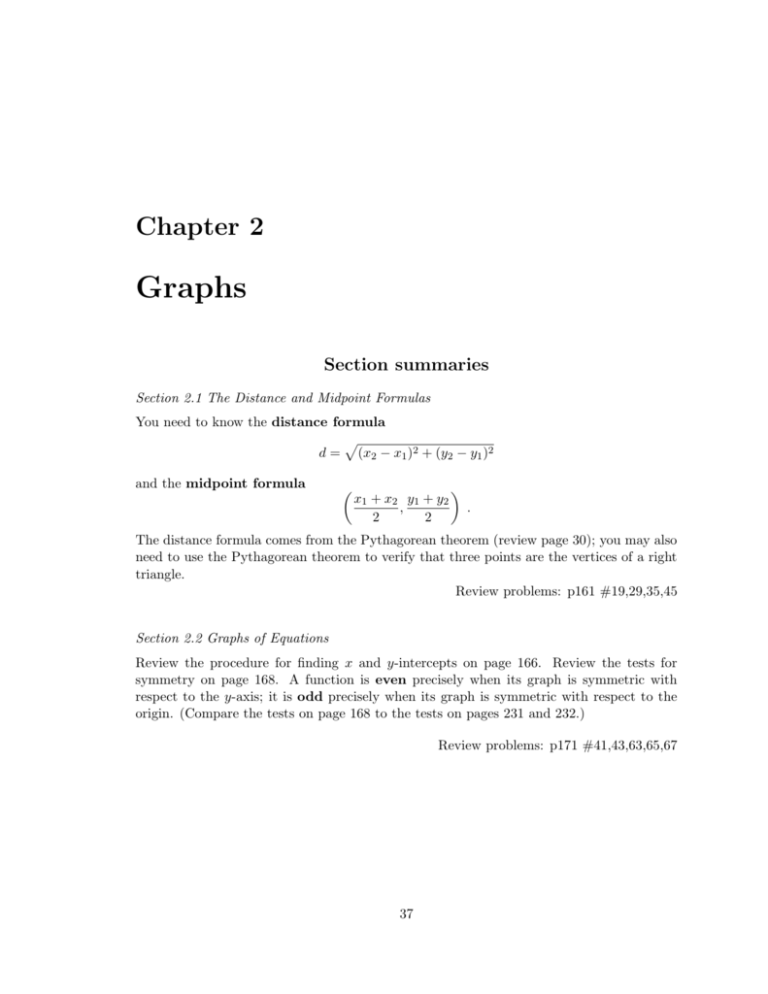
Chapter 2 Graphs Section summaries Section 2.1 The Distance and Midpoint Formulas You need to know the distance formula p d = (x2 − x1 )2 + (y2 − y1 )2 and the midpoint formula x 1 + x 2 y1 + y 2 , 2 2 . The distance formula comes from the Pythagorean theorem (review page 30); you may also need to use the Pythagorean theorem to verify that three points are the vertices of a right triangle. Review problems: p161 #19,29,35,45 Section 2.2 Graphs of Equations Review the procedure for finding x and y-intercepts on page 166. Review the tests for symmetry on page 168. A function is even precisely when its graph is symmetric with respect to the y-axis; it is odd precisely when its graph is symmetric with respect to the origin. (Compare the tests on page 168 to the tests on pages 231 and 232.) Review problems: p171 #41,43,63,65,67 37 38 CHAPTER 2. GRAPHS Section 2.3 Lines The slope of the line segment joining two points (x1 , y1 ) and (x2 , y2 ) is m= y2 − y 1 , x2 − x 1 assuming that x1 6= x2 . The equation of the line through (x1 , y1 ) with slope m is y = m(x − x1 ) + y1 , the point-slope form. The equation of the line with slope m and y-intercept b is y = mx + b , the slope-intercept form. To find the slope of a line in general form Ax + By = C, put it into the slope-intercept form so you can just read off the slope. Remember that a positive slope means that the graph goes up (from left to right) and a negative slope means that the graph heads down. Two different lines y = m1 x + b1 and y = m2 x + b2 are parallel when m2 = m1 , and 1 perpendicular when m2 = − (or, equivalently, when m1 m2 = −1). m1 Review problems: p185 #21,29,57,85,87,113,115,119,131 Section 2.4 Circles The standard form of an equation of a circle with radius r and center (h, k) is (x − h)2 + (y − k)2 = r2 . If you are given an equation in the general form x2 + y 2 + ax + by + c = 0, you can complete the square to put it into the standard form. Review problems: p193 #15,19,29,59 39 Sample Questions 2.1 A. Find the distance between the points (2, 5) and (4, −3). √ √ (a) 2 2 (d) 2 17 (b) 10 √ (c) 10 (e) 68 2.1 B. Find the distance between the points (−1, −3) and (2, 1). (a) 1 √ 5 (b) √ (c) 17 (d) 25 (e) None of these 2.1 C. The midpoint of the line segment joining the points (1, 6) and (−3, 4) is (a) ( 21 , 72 ) (b) ( 27 , 12 ) (d) (−2, −1) (e) (16, 4) (c) (−1, 5) 2.1 #48. Find all points on the y-axis that are 5 units from the point (4, 4). (a) (−1, 0) and (−7, 0) (d) (0, −1) and (0, −7) (b) (0, 5) and (0, 5) (e) None of these (c) (0, 1) and (0, 7) 2.2 #25. The graph of the line with equation 2x + 3y = 6 has (a) x-intercept (3, 0) and y-intercept (0, 2) (b) x-intercept (2, 0) and y-intercept (0, 3) (c) x-intercept (2, 0) and y-intercept (0, 6) (d) x-intercept (6, 0) and y-intercept (0, 3) (e) x-intercept (6, 0) and y-intercept (0, 2) 2.2 #59. Find the x-intercepts of the graph of the equation x2 + y − 9 = 0. √ √ (a) The x-intercepts are 3 and − 3 (d) The only x-intercept is 3 (b) The only x-intercept is −9 (c) The x-intercepts are 3 and −3 (e) None of these 40 CHAPTER 2. GRAPHS 2.2 #61. The graph of the equation 9x2 + 4y 2 = 36 has (a) x-intercept (0, 0) and y-intercept (0, 0) (b) x-intercept (2, 0) and y-intercept (0, 3) (c) x-intercept (3, 0) and y-intercept (0, 2) (d) x-intercepts (2, 0) and (−2, 0) and y-intercepts (0, 3) and (0, −3) (e) x-intercepts (3, 0) and (−3, 0) and y-intercepts (0, 2) and (0, −2) −x3 is symmetric with respect to x2 − 9 (a) the x-axis and y-axis, but NOT the origin. 2.2 #69. The graph of y = (b) the origin, but NOT the x-axis or y-axis. (c) the x-axis and the origin, but NOT the y-axis. (d) the y-axis and origin, but NOT the x-axis. (e) the x-axis, the y-axis and the origin. 2.3 A. The equation of the vertical line passing through the point (4, 7) is (a) x = 4 (d) y = 7 (b) x = 7 (e) 4x = 7y (c) y = 4 2.3 B. Find the slope of the line through the points (−3, −1) and (1, 7). (a) 3 (d) 2 (b) −3 (e) None of these (c) 1 2 2.3 C. Find an equation for the line through (0, 3) and (−2, 0). (a) 2x − 3y + 6 = 0 (d) 2x + 3y − 6 = 0 (b) 3x + 2y − 6 = 0 (e) 3x + 2y + 6 = 0 (c) 3x − 2y + 6 = 0 2.3 Example 8. Find the slope m and y-intercept b of the equation 2x + 4y = 8. (a) m = 1 2 and b = 2 (b) m = − 21 and b = 2 (c) m = 2 and b = 4 (d) m = −2 and b = 4 (e) None of these 41 2.3 #49. The equation of the line containing the points (1, 3) and (−1, 2) is (a) y = 2x + 1 (b) y = − 12 x + (c) y = 21 x + (d) y = −2x + 5 7 2 (e) This is a vertical line, so there is no equation. 5 2 2.3 D. Which of the following is an equation of the line passing through the point (5, −4) and parallel to the line with equation 3x − 5y + 2 = 0? (a) y = 3x − 4 (b) y = 3x − 19 (c) y = 53 x − 7 (d) y = 53 x − 4 (e) y = − 53 x − 9 2.3 #65. Find an equation for the line perpendicular to y = 1 x + 4 containing (1, −2). 2 (a) y = 2x + 4 (d) y = −2x (b) y = −2x − 4 (e) None of these (c) y = 2x 2.3 #67. Find an equation for the line perpendicular to 2x + y = 2 and containing (−3, 0). (a) y = 2(x + 3) (d) y = − 21 (x + 3) (b) y = −2(x + 3) (e) None of these (c) y = 12 (x + 3) 2.3 E. The line which is perpendicular to the line given by y = 4x − 3 and which passes through the point (0, 5) also passes through which of the following points? (a) (4, 0) (d) (4, 6) (b) (4, 13) (e) (4, −11) (c) (4, 4) 2.3 #97. The graph of the line with equation 1 2x + 13 y = 1 has (a) x-intercept (1/2, 0) and y-intercept (0, 1/3) (b) x-intercept (1/3, 0) and y-intercept (0, 1/2) (c) x-intercept (3, 0) and y-intercept (0, 2) (d) x-intercept (2, 0) and y-intercept (0, 3) (e) None of these 42 CHAPTER 2. GRAPHS 2.4 A. The standard form of the equation of the circle with radius 6 and center (−3, −6) is (a) (x + 3)2 + (y + 6)2 = 36 (b) (x − 3)2 + (y − 6)2 = 36 (c) (x + 6)2 + (y + 3)2 = 36 (d) (x − 6)2 + (y − 3)2 = 36 (e) None of these 2.4 #25. The circle x2 + y 2 − 2x + 4y − 4 = 0 has (a) center (1, −2) and radius 9 (d) center (−1, 2) and radius 3 (b) center (1, −2) and radius 3 (e) center (−1, 2) and radius 9 (c) center (−2, 4) and radius 16 2.4 #29. The graph of the equation x2 + y 2 − x + 2y + 1 = 0 is (a) a circle with center (1, −2) and radius 1. (b) a circle with center (−1, 2) and radius 1. (c) a circle with center ( 21 , −1) and radius 1. (d) a circle with center ( 21 , −1) and radius 14 . (e) None of these 2.4 B. The graph of the equation x2 + y 2 − 6x + 2y + 7 = 0 is (a) a circle with center (3, −1) and radius 3. √ (b) a circle with center (3, −1) and radius 3. √ (c) a circle with center (3, 1) and radius 7. √ (d) a circle with center (1, 3) and radius 3. (e) None of these 43 Answer Key 2.1 A. (d) 2.1 B. (e) 2.1 C. (c) 2.1 #48. (c) 2.2 #25. (a) 2.2 #59. (c) 2.2 #61. (d) 2.2 #69. (b) 2.3 A. (a) 2.3 B. (d) 2.3. C. (c) 2.3 Example 8. (b) 2.3 #49. (c) 2.3 D. (c) 2.3 #65. (d) 2.3 #67. (c) 2.3 E. (c) 2.3 #97. (d) 2.4 A. (a) 2.4 #25. (b) 2.4 #29. (e) 2.4 B. (b) Solutions 2.1 A. Find the distance between the points (2, 5) and (4, −3). p Solution: Use the distance formula d = (x2 − x1 )2 + (y2 − y1 )2 withp x2 = 4, x1 = 2, y2 = −3, p y1 = 5. √ √ √ √ d = (4 − 2)2 √ + (−3 − 5)2 = (2)2 + (−8)2 = 4 + 64 = 68 = 2 · 34 = 2 · 2 · 17 Answer: d = 2 17 2.1 B. Find the distance between the points (−1, −3) and (2, 1). p p √ √ Solution: d = (2 − (−1))2 + (1 − (−3))2 = (3)2 + (4)2 = 9 + 16 = 25 = 5 44 CHAPTER 2. GRAPHS 2.1 C. The midpoint of the line segment joining the points (1, 6) and (−3, 4) is x 1 + x 2 y1 + y 2 , , which just averages the Solution: Use the midpoint formula 2 2 −2 10 1−3 6+4 , = , x-coordinates and the y-coordinates. 2 2 2 2 = (−1, 5) 2.1 #48. Find all points on the y-axis that are 5 units from the point (4, 4). Solution: For a point to be on the y-axis its x-coordinate p must be zero. Let (0, y) be the point we are looking for, and use the distance formula: (0 − 4)2 + (y − 4)2 = 5 Solve for y: 16 + (y − 4)2 = 25 (y − 4)2 = 9 y − 4 = ±3 y = 1 or y = 7 The two possible points are (0, 1) and (0, 7). 2.3 A. The equation of the vertical line passing through the point (4, 7) is Solution: The points on the line all have the same x-coordinate, so the equation is x = 4. 2.3 B. Find the slope of the line through the points (−3, −1) and (1, 7). y2 − y 1 8 = 7−(−1) Solution: m= 1−(−3) = 4 = 2 x2 − x 1 2.3 C. Find an equation for the line through (0, 3) and (−2, 0). Solution: These are the choices: (a) 2x − 3y + 6 = 0 (b) 3x + 2y − 6 = 0 (c) 3x − 2y + 6 = 0 (d) 2x + 3y − 6 = 0 (e) 3x + 2y + 6 = 0 You can do this problem by just substituting into the equations. The point (0, 3) lies on lines (b) and (c), since these are the only equations that satisfy x = 0, y = 3. Of these two, only (c) satisfies x = −2 and y = 0, so the answer must be equation (c). 0−3 You can also solve the problem by using the point-slope form. The slope is m = −2−0 = 32 , and the y-intercept is 3 since the line goes through (0, 3). This gives the equation y = 23 x+3. Multiply through by 2 to get 2y = 3x + 6, or 0 = 3x − 2y + 6. 2.3 D. Which of the following is an equation of the line passing through the point (5, −4) and parallel to the line with equation 3x − 5y + 2 = 0? Solution: To be parallel to the given line, the slope must be the same. Convert the given The slope is 53 . equation into point-slopt form: 3x + 2 = 5y or y = 35 x + 25 . The choices are (a) y = 3x − 4 (b) y = 3x − 19 (c) y = 35 x − 7 5 3 (e) y = − 3 x − 9 (d) y = 5 x − 4 Only (c) and (d) have the correct slope. The point (5, −4) lies on line (c). Knowing the slope, you could also use the point-slope form of the equation of a line: y = 53 (x − 5) + (−4) y = 35 x − 3 − 4 y = 35 x − 7 2.3 E. The line which is perpendicular to the line given by y = 4x − 3 and which passes through the point (0, 5) also passes through which of the following points? Solution: The slope of the perpendicular line must be − 41 , and its y-intercept is 5 since it passes through (0, 5), so its equation is y = − 14 x + 5. If x = 4, then y = 4, so the answer is (c). 45 2.4 A. The standard form of the equation of the circle with radius 6 and center (−3, −6) is Solution: Use the standard form of an equation of a circle: (x − h) 2 + (y − k)2 = r2 . You get (x + 3)2 + (y + 6)2 = 36. 2.4 B. The graph of the equation x2 + y 2 − 6x + 2y + 7 = 0 is Solution: The answer is found by completing the square. x2 − 6x + ?? + y 2 + 2y + ?? = −7 x2 − 6x + 9 + y 2 + 2y + 1 = −7 + 9 + 1 (x − 3)2 + (y + 1)2 = 3 √ (x − 3)2 + (y − (−1))2 = ( 3)2 This is a circle with center (3, −1) and radius √ 3.
